A recent visit to Ravensbourne has catalysed a shift in my opinion of 'fashion tech' as a discipline and led to an animated discussion around the reasons for the aesthetic gulf between fashion design and technology. The reason for my visit was the European Space Agency initiative, 'Couture in Orbit' - a fashion show at the Science Museum in May, featuring the work of five fashion colleges in Europe: ESMOD Paris, ESMOD Berlin, Fashion Design Akademiet Copenhagen, Politecnico di Milano and Ravensbourne London, which set about planting creative seeds for what will become a necessity - fashion in space. The colleges worked to a brief set by the ESA to present ideas and prototypes for fashion and accessories in the coming age of space travel. In response to a number of nasty and aggressive comments on their YouTube page in response to a video of this initiative, the ESA wrote this:
Yes, the designs could be seen as somewhat 'amateurish' and 'costumey' in their concept and presentation and describing them as 'couture' and 'fashion' is not strictly accurate, however the idea here is key. Fashion's robust approach to design and creation of cohesive, refined collections does not allow for this kind of playful theatrics, but if fashion and tech are to advance there has to be some latitude where the end result is concerned. It makes no sense to judge this by the same standards as a show at London Fashion Week, for example, which exists for an entirely different purpose and is part of a totally different creative and commercial conversation. The YouTube comments demonstrate an attitude that demeans the validity and power of fashion that I have seen previously hinder cooperation between fashion, science and tech sectors, but we will forge forward regardless.
![2016-07-15-1468605443-1663483-www.GIFCreator.me_7XyGhd.gif]()
'Couture in Orbit' designs
'It is inevitable', said Ravensbourne students Farid Bin Karim and Sam Martin-Harper of the fusion of fashion and technology in clothing to come. Their view was the same of space travel - we know for certain there will be inhabitation of other planets and commercial journeys to space, so we need to design clothing fit for space life.
The brief provided to the students by the ESA included an array of materials for them to use in their garments and accessories, including Sympatex, woven fabrics by Bionic Yarn and 37.5. Being presented with a fixed set of materials is challenging from a design perspective, as fashion design often begins with selection of a fabrics to complement an aesthetic or theme held by the designer. Removing this from the designer's creative point of view throws up further challenges and provides experimental opportunities.
Karim leads me into a discussion about Design Fiction, a framework based on critical design which is the foundation of his speculative design approach on the Wearables MA course at Ravensbourne. The modelling of future scenarios using design fiction provides a robust outline for predicting what fashion design could be in an age of commercial space travel, for example.
Karim selects three modes of technology - one that exists but he can't access, one that exists that he can access, and one that we can reasonably deduce will exist in the future - with which to begin to form a fashion tech product design scenario. This Design Fiction framework and critical design, attributed to Julian Bleecker and Dunne and Raby respectively, and adopted widely in London as a modelling tool, begins to give me insight into how design for a future that we can't yet imagine is conceivable and believable.
Farid explains that his self-closing helmet and kilt are inspired by sojourners travelling to space and creating their own exoplanet. His concept hinged on the sojourners creating protective barriers around themselves that responded to atmospheric changes to give visual notifications allowing them to react and adapt. His self-closing helmet is powered by muscle wires and his kilt, printed in collaboration with print designer and MA fashion student Laura Perry, has heat responsive ink which disappears at certain temperatures - a useful visual notification when things are hotting up. Farid also used a UV responsive pigment - another useful visual alert. Karim's work is inspired by an array of creatives including artist Lucy McRae, writer HG Wells and movement artist and coder Nicola Plant.
![2016-07-15-1468605537-699944-DSC02293.jpg]()
Farid Bin Karim's self-closing helmet and reactive ink kilt, in collaboration with Laura Perry
![2016-07-15-1468605577-8603199-DSC02298.jpg]()
Heat applied by the palm of the hand causes the ink to temporarily disappear
![2016-07-15-1468605626-929806-DSC02300.jpg]()
UV source applied to printed fabric
![2016-07-15-1468605669-9715944-DSC02299.jpg]()
Visual alert to excessive UV rays
Sam Martin-Harper presented an altogether more nostalgic proposition in which she expressed her belief (and hope) that we will always remain rooted to earth. Her love of biology and particular interest in the techniques for growing plants on the International Space Station, including the work of astronaut Tim Peake, drove her to create a 3D printed neck piece containing plant life.
Admitting this is a conceptual piece, Sam explained how she used inspiration from the ingenious folding joint sections of space suits to inform the shapes and details of her design. Sam is completing her BA and is still exploring career options. One thing is for sure, she cannot see a future of fashion without the integration of tech.
![2016-07-15-1468605729-7038567-IMG_1283.JPG]()
Sam Martin-Harper's 3D printed plant-filled neckpiece at 'Couture in Orbit"
A discussion on the future work of Farid centres on his passion for data as a tool for creating responsive and adaptive design. He has been learning coding and electronics as part of his Wearables MA and sees future fashion as an extension of the individual - as 'body centric'. On graduation, Karim is hoping to work with a multi-disciplinary research facility to conduct collaborative research and design.
When I ask if he would consider a traditional design job (he is a fashion graduate, after all) he reflects on how he has had to unlearn and relearn aspects of his design approach through his Wearable MA training in order to realise his part industrial, part fashion creations. It's clear he's happier in unchartered territory.
The discussion turned to couture and obsolescence. Karim is curious about the possible inclusion of technology in couture techniques in order to aid their survival, but this is completely at odds with the fact that couture means made by hand. This meaning of couture would therefore need to change for this to happen. I ponder a possible alternative in the form of technologies so specialised, rare and unique that they create a techno-couture instead. Here we begin to think about fashion and design being driven by technology, rather than the other way around.
In these discussions, as Alexa Pollmann, Course Leader of the MA Wearable Futures course, points out, it is important to consider the designs of Sam, Farid and the other students from Ravensbourne as proposals and prototypes - not final 'fashion products' per se.
Ask any fashion designer working in the industry today their opinion of fashion tech and they will overwhelmingly tell you that it is gimmicky, ugly and not desirable. Herein lies the chasm between tech and fashion. Looks really count, and so does magic. Fashion designers bring an ephemeral quality to their creations, says Alexa. Fashion designers dream up and articulate experiences better than any other design discipline. They create magic in a way that is often so difficult to define it just feels 'right'. Fashion is entirely subjective and indisputably powerful. For these reasons, Clive Van Heerden, co-founder of vHM Design Futures studio in London, which develops materials and technologies for a host of Wearable Electronic business propositions in the areas of electronic apparel, conductive textiles, physical gaming, medical monitoring and entertainment, insists on having a fashion designer in his creative team on all projects.
![2016-07-15-1468605784-8691183-DSC02070.jpg]()
![2016-07-15-1468605868-4199822-DSC02181.jpg]()
Designs by students from Politecnico di Milano
![2016-07-15-1468605916-6830848-DSC02158.jpg]()
Designs by students from Ravensbourne
But why are fashion designers resistant to incorporating tech into their designs and what is slowing down the advancement of the fashion tech fusion? One factor is that the development of tech-enabled/collaborative products takes considerable research and development, and therefore time. It requires dedication to solving specific problems related to firstly a single concept or product, which is at odds with designing, sampling and creating whole fashion collections which are visually cohesive within a strict time frame (weeks or months at most), which then have a finite sales period before the next collection is created (making the current one obsolete, for want of a better word) and the cycle continues.
The traditional cycle of two main collections per year for high end fashion labels has switched to four in recent years, meaning there is even less time for research and development. Knowing this, it is easy to see why the work of fashion designers is at odds with the research and development required to incorporate tech, and vice versa. In a previous interview with designers Fyodor Golan, they pointed out that fashion tech collaborations often have a required fixed outcome within a tight time frame, limiting the amount of integration possible. This goes some way to explaining why sometimes fashion tech looks more 'stuck on' than cohesively and meaningfully designed and produced.
Read more about the technologies involved in the Couture in Orbit project here
Header image: Farid Bin Karim's self-closing helmet and adaptable ink kilt at 'Couture in Orbit'
Originally posted on Techstyler.fashion
Follow me Instagram
Subscribe to Techstyler
Couture in Orbit is a student outreach project. The students are using materials and technology in their designs that are a spin-off from the space industry. Each school had a theme linked to an astronaut's mission, such as environment, health, sustainability, and their final designs had to have practical benefits for life on Earth. No funds were exchanged and material and technical support was provided by Tech startups.
Yes, the designs could be seen as somewhat 'amateurish' and 'costumey' in their concept and presentation and describing them as 'couture' and 'fashion' is not strictly accurate, however the idea here is key. Fashion's robust approach to design and creation of cohesive, refined collections does not allow for this kind of playful theatrics, but if fashion and tech are to advance there has to be some latitude where the end result is concerned. It makes no sense to judge this by the same standards as a show at London Fashion Week, for example, which exists for an entirely different purpose and is part of a totally different creative and commercial conversation. The YouTube comments demonstrate an attitude that demeans the validity and power of fashion that I have seen previously hinder cooperation between fashion, science and tech sectors, but we will forge forward regardless.
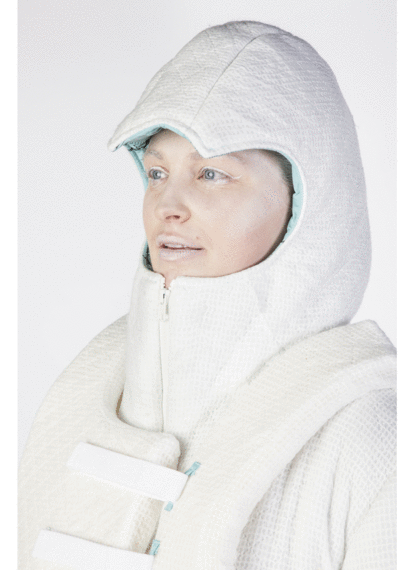
'It is inevitable', said Ravensbourne students Farid Bin Karim and Sam Martin-Harper of the fusion of fashion and technology in clothing to come. Their view was the same of space travel - we know for certain there will be inhabitation of other planets and commercial journeys to space, so we need to design clothing fit for space life.
The brief provided to the students by the ESA included an array of materials for them to use in their garments and accessories, including Sympatex, woven fabrics by Bionic Yarn and 37.5. Being presented with a fixed set of materials is challenging from a design perspective, as fashion design often begins with selection of a fabrics to complement an aesthetic or theme held by the designer. Removing this from the designer's creative point of view throws up further challenges and provides experimental opportunities.
Karim leads me into a discussion about Design Fiction, a framework based on critical design which is the foundation of his speculative design approach on the Wearables MA course at Ravensbourne. The modelling of future scenarios using design fiction provides a robust outline for predicting what fashion design could be in an age of commercial space travel, for example.
Karim selects three modes of technology - one that exists but he can't access, one that exists that he can access, and one that we can reasonably deduce will exist in the future - with which to begin to form a fashion tech product design scenario. This Design Fiction framework and critical design, attributed to Julian Bleecker and Dunne and Raby respectively, and adopted widely in London as a modelling tool, begins to give me insight into how design for a future that we can't yet imagine is conceivable and believable.
Farid explains that his self-closing helmet and kilt are inspired by sojourners travelling to space and creating their own exoplanet. His concept hinged on the sojourners creating protective barriers around themselves that responded to atmospheric changes to give visual notifications allowing them to react and adapt. His self-closing helmet is powered by muscle wires and his kilt, printed in collaboration with print designer and MA fashion student Laura Perry, has heat responsive ink which disappears at certain temperatures - a useful visual notification when things are hotting up. Farid also used a UV responsive pigment - another useful visual alert. Karim's work is inspired by an array of creatives including artist Lucy McRae, writer HG Wells and movement artist and coder Nicola Plant.
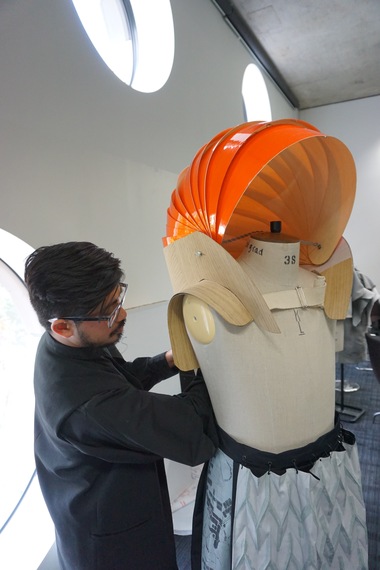

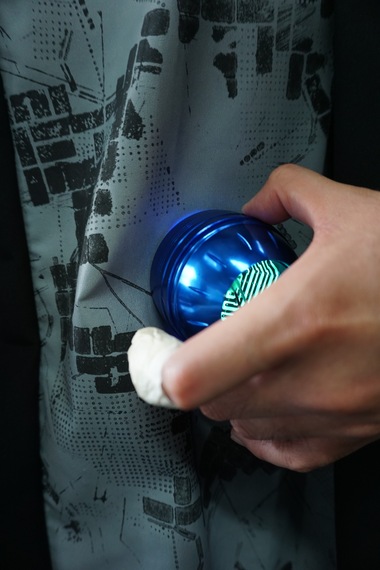
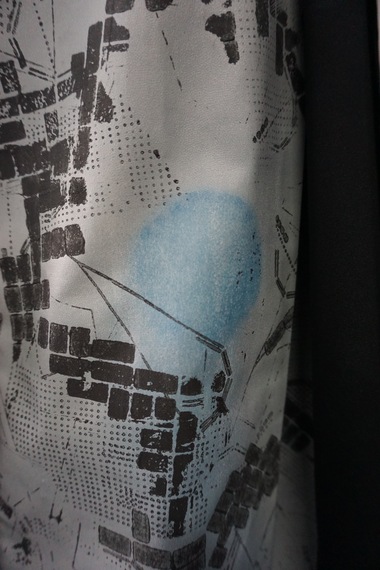
Sam Martin-Harper presented an altogether more nostalgic proposition in which she expressed her belief (and hope) that we will always remain rooted to earth. Her love of biology and particular interest in the techniques for growing plants on the International Space Station, including the work of astronaut Tim Peake, drove her to create a 3D printed neck piece containing plant life.
Admitting this is a conceptual piece, Sam explained how she used inspiration from the ingenious folding joint sections of space suits to inform the shapes and details of her design. Sam is completing her BA and is still exploring career options. One thing is for sure, she cannot see a future of fashion without the integration of tech.
A discussion on the future work of Farid centres on his passion for data as a tool for creating responsive and adaptive design. He has been learning coding and electronics as part of his Wearables MA and sees future fashion as an extension of the individual - as 'body centric'. On graduation, Karim is hoping to work with a multi-disciplinary research facility to conduct collaborative research and design.
When I ask if he would consider a traditional design job (he is a fashion graduate, after all) he reflects on how he has had to unlearn and relearn aspects of his design approach through his Wearable MA training in order to realise his part industrial, part fashion creations. It's clear he's happier in unchartered territory.
The discussion turned to couture and obsolescence. Karim is curious about the possible inclusion of technology in couture techniques in order to aid their survival, but this is completely at odds with the fact that couture means made by hand. This meaning of couture would therefore need to change for this to happen. I ponder a possible alternative in the form of technologies so specialised, rare and unique that they create a techno-couture instead. Here we begin to think about fashion and design being driven by technology, rather than the other way around.
In these discussions, as Alexa Pollmann, Course Leader of the MA Wearable Futures course, points out, it is important to consider the designs of Sam, Farid and the other students from Ravensbourne as proposals and prototypes - not final 'fashion products' per se.
Ask any fashion designer working in the industry today their opinion of fashion tech and they will overwhelmingly tell you that it is gimmicky, ugly and not desirable. Herein lies the chasm between tech and fashion. Looks really count, and so does magic. Fashion designers bring an ephemeral quality to their creations, says Alexa. Fashion designers dream up and articulate experiences better than any other design discipline. They create magic in a way that is often so difficult to define it just feels 'right'. Fashion is entirely subjective and indisputably powerful. For these reasons, Clive Van Heerden, co-founder of vHM Design Futures studio in London, which develops materials and technologies for a host of Wearable Electronic business propositions in the areas of electronic apparel, conductive textiles, physical gaming, medical monitoring and entertainment, insists on having a fashion designer in his creative team on all projects.
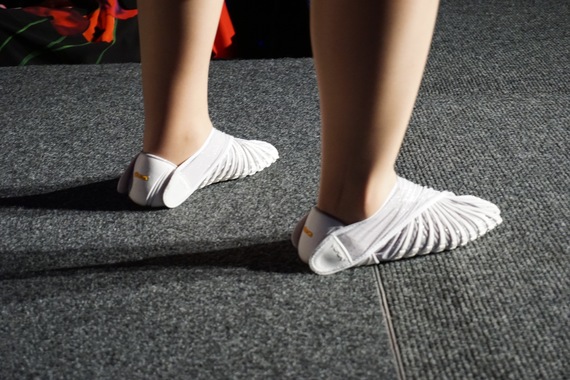
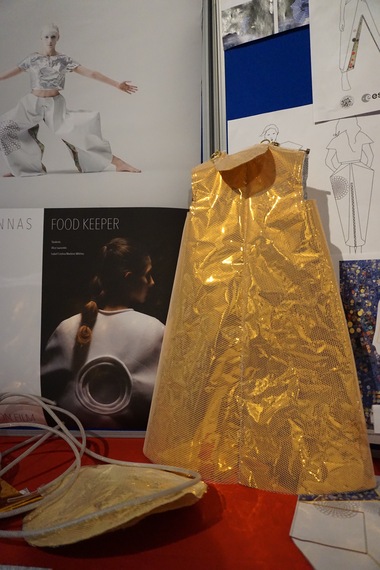

But why are fashion designers resistant to incorporating tech into their designs and what is slowing down the advancement of the fashion tech fusion? One factor is that the development of tech-enabled/collaborative products takes considerable research and development, and therefore time. It requires dedication to solving specific problems related to firstly a single concept or product, which is at odds with designing, sampling and creating whole fashion collections which are visually cohesive within a strict time frame (weeks or months at most), which then have a finite sales period before the next collection is created (making the current one obsolete, for want of a better word) and the cycle continues.
The traditional cycle of two main collections per year for high end fashion labels has switched to four in recent years, meaning there is even less time for research and development. Knowing this, it is easy to see why the work of fashion designers is at odds with the research and development required to incorporate tech, and vice versa. In a previous interview with designers Fyodor Golan, they pointed out that fashion tech collaborations often have a required fixed outcome within a tight time frame, limiting the amount of integration possible. This goes some way to explaining why sometimes fashion tech looks more 'stuck on' than cohesively and meaningfully designed and produced.
Read more about the technologies involved in the Couture in Orbit project here
Header image: Farid Bin Karim's self-closing helmet and adaptable ink kilt at 'Couture in Orbit'
Originally posted on Techstyler.fashion
Follow me Instagram
Subscribe to Techstyler